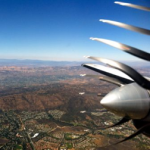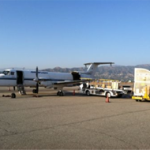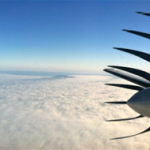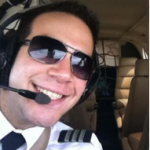 Flying in Southern California is a nice change from the norm of Central Florida.
Flying in Southern California is a nice change from the norm of Central Florida.
It’s different because of the weather factors; high terrain, and air traffic saturation, amongst others. SoCal has generally more stable and favorable weather; there’s fog typically in the mornings, not so much rain, and it’s definitely not as humid. Although I can say that learning to fly at ERAU Daytona Beach has prepared me well, as Florida is the thunderstorm/lightning capital of the world. If you ever looked at an atlas, it’s a no-brainer that California has mountains and valleys, as opposed to being flat and swampy. We learn about mountainous operations in ground school, but to actually experience it first-hand is invaluable. I highly recommend that all pilots experience it, although Prescott campus pilots can obviously fulfill that, since they live at 5,000 ft MSL. The air traffic infrastructure in Los Angeles is Class B (the highest class of saturation in the US), and having flown through the Class B of Orlando, Miami, Tampa and New York, I feel I’ve been able to adapt pretty well.
 Flying the Beech 1900 is just like flying a big King Air, in fact Beechcraft even refers to the aircraft as a grown-up King Air in the manuals. It was originally developed to be a business aircraft but the airlines loved it so much that it became one of the most popular turboprops of its time. In a passenger configuration it seats 19 people, and in a cargo configuration we can typically carry 5,500 lbs.
Flying the Beech 1900 is just like flying a big King Air, in fact Beechcraft even refers to the aircraft as a grown-up King Air in the manuals. It was originally developed to be a business aircraft but the airlines loved it so much that it became one of the most popular turboprops of its time. In a passenger configuration it seats 19 people, and in a cargo configuration we can typically carry 5,500 lbs.
 As the regional-jet market expanded, many carriers got rid of their 1900s to adapt to their changing mission. Despite this, it is a very capable aircraft and valuable to cargo airlines for its bulk capability, climb performance, cruise speed, and versatility.
As the regional-jet market expanded, many carriers got rid of their 1900s to adapt to their changing mission. Despite this, it is a very capable aircraft and valuable to cargo airlines for its bulk capability, climb performance, cruise speed, and versatility.
Speaking of cargo, which is carried on passenger aircraft too, cargo-only aircraft have the ability to carry  more hazardous materials legally. Hazardous materials include items like dry ice, batteries, medical specimens, and low-TI radioactive material. All pilots receive training to comply with the federal regulations on transporting these items in their first few weeks of ground school training. Fines for mishandling these goods are pretty hefty and it is important to maintain the level of safety needed each and every day.
more hazardous materials legally. Hazardous materials include items like dry ice, batteries, medical specimens, and low-TI radioactive material. All pilots receive training to comply with the federal regulations on transporting these items in their first few weeks of ground school training. Fines for mishandling these goods are pretty hefty and it is important to maintain the level of safety needed each and every day.

Over and Out.


